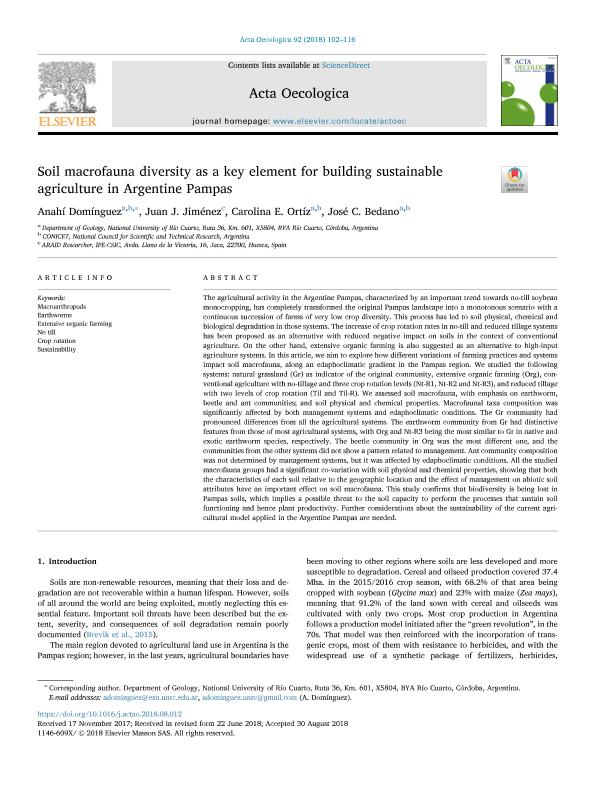Artículo
Soil macrofauna diversity as a key element for building sustainable agriculture in Argentine Pampas
Fecha de publicación:
08/2018
Editorial:
Gauthier-Villars/Editions Elsevier
Revista:
Acta Oecologica
ISSN:
1146-609X
Idioma:
Inglés
Tipo de recurso:
Artículo publicado
Clasificación temática:
Resumen
The agricultural activity in the Argentine Pampas, characterized by an important trend towards no-till soybean monocropping, has completely transformed the original Pampas landscape into a monotonous scenario with a continuous succession of farms of very low crop diversity. This process has led to soil physical, chemical and biological degradation in those systems. The increase of crop rotation rates in no-till and reduced tillage systems has been proposed as an alternative with reduced negative impact on soils in the context of conventional agriculture. On the other hand, extensive organic farming is also suggested as an alternative to high-input agriculture systems. In this article, we aim to explore how different variations of farming practices and systemsimpact soil macrofauna, along an edaphoclimatic gradient in the Pampas region. We studied the following systems: natural grassland (Gr) as indicator of the original community, extensive organic farming (Org), conventionalagriculture with no-tillage and three crop rotation levels (Nt-R1, Nt-R2 and Nt-R3), and reduced tillage with two levels of crop rotation (Til and Til-R). We assessed soil macrofauna, with emphasis on earthworm, beetle and ant communities; and soil physical and chemical properties. Macrofaunal taxa composition was significantly affected by both management systems and edaphoclimatic conditions. The Gr community had pronounced differences from all the agricultural systems. The earthworm community from Gr had distinctivefeatures from those of most agricultural systems, with Org and Nt-R3 being the most similar to Gr in native and exotic earthworm species, respectively. The beetle community in Org was the most different one, and the communities from the other systems did not show a pattern related to management. Ant community composition was not determined by management systems, but it was affected by edaphoclimatic conditions. All the studied macrofauna groups had a significant co-variation with soil physical and chemical properties, showing that boththe characteristics of each soil relative to the geographic location and the effect of management on abiotic soil attributes have an important effect on soil macrofauna. This study confirms that biodiversity is being lost in Pampas soils, which implies a possible threat to the soil capacity to perform the processes that sustain soil functioning and hence plant productivity. Further considerations about the sustainability of the current agricultural model applied in the Argentine Pampas are needed.
Archivos asociados
Licencia
Identificadores
Colecciones
Articulos(CCT - CORDOBA)
Articulos de CTRO.CIENTIFICO TECNOL.CONICET - CORDOBA
Articulos de CTRO.CIENTIFICO TECNOL.CONICET - CORDOBA
Citación
Domínguez, Anahí; Jiménez, Juan José; Ortíz, Carolina E.; Bedano, José Camilo; Soil macrofauna diversity as a key element for building sustainable agriculture in Argentine Pampas; Gauthier-Villars/Editions Elsevier; Acta Oecologica; 92; 8-2018; 102-116
Compartir
Altmétricas




